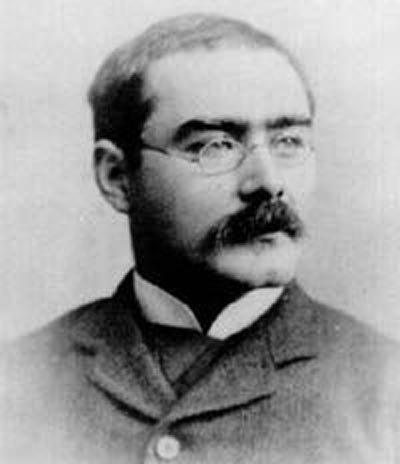
Rudyard Kipling was born in Bombay, India, where his father, John Lockwood Kipling, was an arts and crafts teacher at the Jeejeebhoy School of Art. His mother, the former Alice Macdonald, was a sister-in-law of the painter Edward Burne-Jones. India was at that time ruled by the British. Ruddy, as Kipling was affectionally called, was brought up by an ayah, who taught him Hidustani as his first language.
Kipling’s writings at the age of thirteen were influenced by the pre-Raphaelites—and he also had family connections to them: two of his mother’s sisters were married into the pre-Raphaelite community. At the age of six he was taken to England by his parents and left for five years at a foster home at Southsea. Kipling, who was not accustomed to traditional English beatings, expressed later his feeling of the treatment in the short story ‘Baa Baa, Black Sheep’, in the novel The Light That Failes (1890), and in his autobiography (1937).
In 1878 Kipling entered United Services College, a boarding school in North Devon. It was an expensive institution that specialized in training for entry into military academies. His poor eyesight and mediocre results as a student ended hopes about military career. However, these years Kipling recalled in lighter tone in one of his most popular books, Stalky & Co (1899). Kipling’s bookishness separated him from the other students; he had to wear glasses and was nicknamed “Gigger”, for gig (carriage) for lamps.
Kipling returned to India in 1882, where he worked as a journalist in Lahore for Civil and Military Gazette (1882-87) and an assistant editor and overseas correspondent in Allahabad for Pioneer (1887-89). The stories written during his last two years in India were collected in The Phantom Rickshaw. It that included the famous story ‘The Man Who Would Be a King.’
Kilping’s short stories and verses gained success in the late 1880s in England, to which he returned in 1889, and was hailed as a literary heir to Charles Dickens. When he toured Japan he criticized the Japanese middle-class for its eagerness to adopt western fashions and values. Between the years 1889 and 1892, Kipling lived in London and published Life’s Handicap (1891), a collection of Indian stories that included ‘The Man Who Was,’ and Barrack-Room Ballads, a collection of poems.
In 1892 Kipling married Caroline Starr Balestier, the sister of an American publisher and writer, with whom he collaborated a novel, The Naulahka (1892). The young couple moved to the United States. Kipling was dissatisfied with the life in Vermont, and after the death of his daughter, Josephine, Kipling took his family back to England and settled in Burwash, Sussex. According to the author’s sister, Kipling became a “harder man”—but also his political beliefs started to stiffen. During these years Kipling produced Many Inventions (1893), Jungle Book (1894), a collection of animal stories for children, The Second Jungle Book (1895), and The Seven Seas (1896).
Widely regarded as unofficial poet laureate, Kipling refused this and many honours, among them the Order of Merit. During the Boer War in 1899 Kipling spent several months in South Africa. In 1902 he moved to Sussex, also spending time in South Africa, where he was given a house by Cecil Rhodes, the influential British colonial statesman. In 1901 appeared Kim, widely considered Kipling’s best novel. The story, set in India, depicted adventures of an orphaned son of a sergeant in an Irish regiment.
Soon after Kipling had received the Nobel Prize, his output of fiction and poems began to decline. In 1923 Kipling published The Irish Guards In The Great War, a history of his son’s regiment. Between the years 1922 and 1925 he was a rector at the University of St. Andrews. Kipling died on January 18, 1936 in London, and was buried in Poet’s Corner at Westminster Abbey. Kipling’s autobiography, Something Of Myself, appeared posthumously in 1937.

